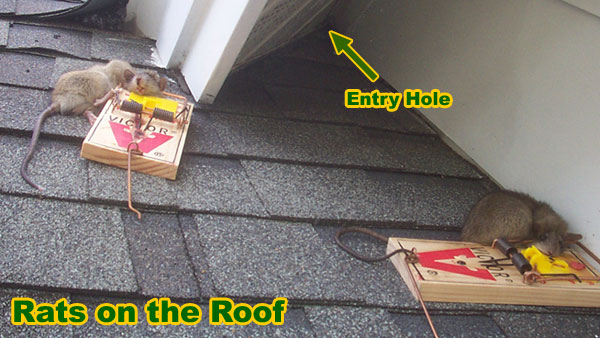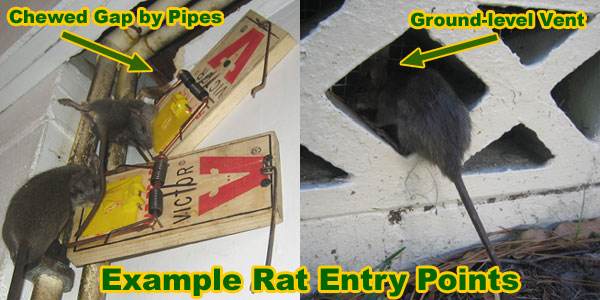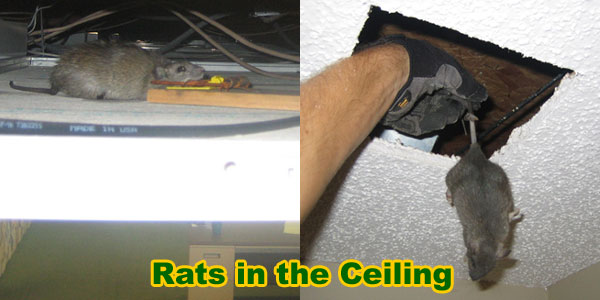- info@wildlife-removal.com
Call us for help in your town
Wildlife Removal Education
How are Rats Getting Into My House?
Need rat removal in your hometown? We service over 500 USA locations! Click here to hire us in your town and check prices - updated for year 2020.
Okay! This is the important step - find out how they are getting into the building! There are two major rat species: the Norway Rat, which is more
common in the north, and which lives more on the ground. And the Roof Rat, which is more common in the south, and which lives up in trees and attics
and such. Some places have both rats.

First, inspect the roof! That's actually where most rats get inside. See that area where an eave meets up against the roof? It's the #1 spot for
rat entry! No home builders or roofers ever seal that area! It's just a wide open spot, and rats only need like a half-inch to squeeze their way
in. Seal those areas up! And if your roof meets the gutter at the edge - sometimes roofers just leave a gap there between the roof and fascia
board! A very easy area for rats to get in! Don't forget all the vents - dormer vents, and roof vents of all kinds. And the plumbing stacks. I've
seen rats get into those, because sometimes there are gaps in the pipes for the rats to get into. The base of the chimney, any roof lines, etc.
Check it all. A knowledge of rat behavior helps, and experience definitely counts for a lot, so if you need help, click on this
map of
Professional Rat Removal Companies serving every town/city in the USA.

Now look here. Some more rat entry spots. They were crawling up the pipes along the wall (actually, they can climb almost any wall, pipes or not, you'd be amazed) and going into
a gap where the pipe goes into the wall. I know, of course, because I screwed some traps along there, and caught the rats! And on the right, we see a rat going into a ground-level
vent. If these areas are not sealed with STEEL SCREEN, thick steel screen, they'll just chew their way right in, and then they can crawl up the walls or get anywhere inside
the house. Every inch of the building must be inspected, and every opening must be repaired. See my rat damage photos - just so you know
what signs to look for.

Once inside, you'll get rats in the ceiling, because they can fit in very tight areas, and they like to go in the ceilings. You will hear the pitter-patter of little feet, and
scratching, mostly at night, above your head.

Rats in the walls - another common place for rats to go. It's common to hear them running up and down the walls of the building.
How to trap a rat - you're going to have to trap a few as well, so you need to read this too.
How to get rid of rats - just another general guide
with lots of information.
How to kill a rat - another guide, helping to humanely solve the problem.
How Long Does It Take For Rats to Breed in the Attic? - a guide to rat breeding in the attic.
How to Get Rid of Rats and a Nest in the Attic - a guide to removing nests in the attic.
What to Do About Rats in the Home - a guide to handling rats inside your home.
Noises Rats Make When They Live In Your House - how to identify common rat noises.
I will now address some of the more common questions that I receive about rats getting into a building:
Rodents in the attic - yup, that's the most common problem that I deal with, but completely solveable using the instructions found on this website, or by hiring one of the professionals that I list on this site.
Rodents in the basement - most commonly going to be the Brown Rat, or Norway rat if it's in the cellar, but mice can also go in the basement as well. Set traps along the walls. Read more on my rats in the basement page.
Rodents in the building - they just love to live in buildings, for the safety, warmth, and as a good nesting ground. Rodents are commensal animals, meant to live with people. You just don't want them to do so.
Rodents in the barn - if the barn has animal food, it will be a rodent magnet. Clean up the food as best you can, because it's not really practical to seal the openings leading into a barn.
Rodents in the car - they can and do chew on the hoses and wires in an automobile. Best bet is to keep a car locked in the garage, or spray the wires with ropel.
Rodents in the compost - try to keep the compost or any garbage contained, or else rats will seek it out.
Rodents in the ceiling - it's pretty much impossible to set traps in a cathedral ceiling or the ceiling in an area between the floors of a house, but I've caught a ton of rats by setting traps in the drop ceiligns of offices.
Rodents in the crawl space - a crawlspace can refer to an attic or the space under an elevated home. In the latter case, I've caught plenty of rats underneath homes. Just set snap traps down there.
Rodents in the garage - a common ailment, since garages are often not very well sealed off. If you want to get rid of the problem of rats in the garage, you've got to seal the garage shut as well.
Rodents in the garden - many animals eat human crops. It's a hard problem to solve. I mostly deal with rodents in buildings.
Rodents in the house - if they are inside the living room or bathroom or any other area, you can set traps inside to get rid of them, but be careful about pets and children.
Rodents in the home - also, again your best bet is to seal the areas outside of the home, and that prevents them from getting inside the home in the first place.
Rodents in the kitchen - look at the power supply behind the stove. That's a hot spot for rodent entry into the kitchen. You can set traps in the pantry or cabinets if you need to.
Rodents in the mobile home - just like any other home, you've got to seal the openings shut, or you won't solve the problem.
Rodents on the roof - the reason they're on the roof is because they've got a way to get into the attic. So address that first. You can set traps on the roof if you want to.
Rodents in the restaurant - a big problem that could have the health inspector shutting the place down. Never use poison in this situation. You don't want your restaurant to stink, do you?
Rodents in the shed - you're going to have to seal the open gaps in the shed if you want to keep them out.
Rodents in the trees - absolutely nothing you can do to keep rodents out of your trees.
Rodents in the walls - you can't set traps inside walls, but if you hear a rat stuck and scratching at the bottom of a wall, you'll have to cut a hole to get it out, or else it will die and rot and stink down there.
Rodents in the yard - aside from keeping things clean, there's nothing you can do about this.
Rodents in the back yard - although I guess getting a cat will help. Just don't leave cat food outside, or you'll end up attracting more rodents than you scare away.
Rodents in the apartment or loft - I went to Oxford this past summer, and I heard all about rats in the loft. Have your landlord pay for professional rodent control!
Rodents in the oven - I've removed several dead rats from inside stoves and ovens. Rats who chewed on the electrical power supply, and then died in the oven.
Rodents in the pantry - yep, it happens, and you can set traps in the pantry to take care of it.
Rodents in the pipes - this happens as well. If there's water in the pipes, you should be fine. Otherwise, you'll want to check for any openings in the pipes.
Rodents in the toilet - a big concern, but something that rarely happens. Do you really think a rat is going to jump out of the toilet and bite your butt? If there's water in the toilet, the chances are practically zero.
Rodents in the wood pile - like any debris, a wood pile is an attractant for rats. Clear it out if you want to lessen the rats on your property.
Customer
Rat Email: Dear David, I have had a serious problem with rats in my house--kitchen, bedrooms, in the walls, etc. I believe they began coming in from the garage
which has been filled with junk for years. They ate through parts of my wooden door, through drywall, and even through wood along the sliding glass doors. I have been zapping
them with the Rat Zapper, but I keep finding their feces all over and know it is dangerous. I am taking steps to arrange for the garage to be emptied and cleaned and have cleaned
out my pantry, cleaned off all the lids, jars, etc, but I still see rat droppings in the living room and in two of the bedrooms. My kids are coming home to stay and I am fearful
of disease. Can you clean those areas up and work simultaneously on sealing out entryways? Is it okay to use a dry vacuum to vacuum them up if I spray them well with Clorox first
and then throw the vacuum away. I do not have the fancy masks, only the white ones. Is that dangerous. I want to get rid of these rats in my house once and for all, then
clean up. Please let me know what you recommend and costs for your services. thank you. Denise
My Response: Denise - I don't live in your area, but you can hire a company from my directory to do a good job. As I state on my websites, the only way to solve a rat problem
is to find and seal the entry holes - as you've noticed, they can chew through almost anything, so I use steel mesh and steel flashing to keep them out when I do my repairs. Only
after they are gone will cleaning be effective. I use special cleaners, but bleach will work fine for your kitchen surfaces.


















